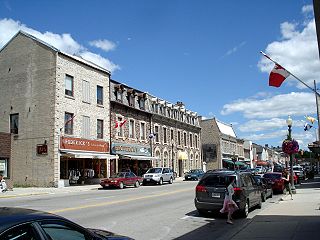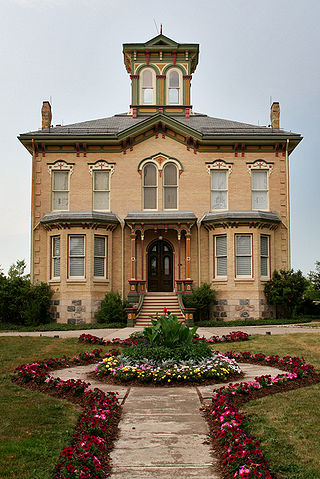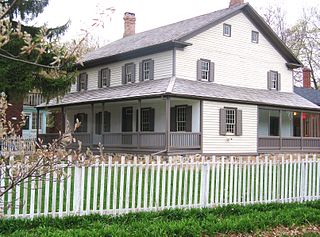
Waterloo is a city in the Canadian province of Ontario. It is one of three cities in the Regional Municipality of Waterloo. Waterloo is situated about 94 km (58 mi) west-southwest of Toronto, but it is not considered to be part of the Greater Toronto Area (GTA). Due to the close proximity of the city of Kitchener to Waterloo, the two together are often referred to as "Kitchener–Waterloo", "K-W", or "The Twin Cities".

Kitchener is a city in the Canadian province of Ontario, about 100 km (62 mi) west of Toronto. It is one of three cities that make up the Regional Municipality of Waterloo and is the regional seat. Kitchener was known as Berlin until a 1916 referendum changed its name. The city covers an area of 136.86 km2, and had a population of 256,885 at the time of the 2021 Canadian census.

Guelph is a city in Southwestern Ontario, Canada. Known as The Royal City, it is roughly 22 km (14 mi) east of Kitchener and 70 km (43 mi) west of Downtown Toronto, at the intersection of Highway 6, Highway 7 and Wellington County Road 124. It is the seat of Wellington County, but is politically independent of it.

Cambridge is a city in the Regional Municipality of Waterloo, Ontario, Canada, located at the confluence of the Grand and Speed rivers. The city had a population of 138,479 as of the 2021 census. Along with Kitchener and Waterloo, Cambridge is one of the three core cities of Canada's tenth-largest metropolitan area.

Kilmainham Gaol is a former prison in Kilmainham, Dublin, Ireland. It is now a museum run by the Office of Public Works, an agency of the Government of Ireland. Many Irish revolutionaries, including the leaders of the 1916 Easter Rising, were imprisoned and executed in the prison by the orders of the UK Government.

The Regional Municipality of Waterloo is a metropolitan area of Southern Ontario, Canada. It contains the cities of Cambridge, Kitchener and Waterloo, and the townships of North Dumfries, Wellesley, Wilmot and Woolwich. Kitchener, the largest city, is the seat of government.

Wellington County is a county located in Southwestern Ontario, Canada and is part of the Greater Golden Horseshoe. The county, made up of two towns and five townships, is predominantly rural in nature. However many of the residents in the southern part of the county commute to urban areas such as Guelph, Kitchener, Waterloo, Brampton, Mississauga, Toronto and Hamilton for employment. The northern part of the county is made up of mainly rural farming communities, except for a few larger towns such as Mount Forest and Arthur. According to the 2021 census, the population of the county was 241,026.

The Township of Woolwich is a rural township in Southwestern Ontario, Canada, considered as a municipality. The Township is located in the northeast part of Waterloo Region and is made up of 10 small communities, with Elmira, Ontario the largest and St. Jacobs, Ontario the second largest. The population at the time of the 2021 Census was 26,999, up from the 2016 population of 25,006. Waterloo Region is still home to the largest population of Old Order Mennonites in Canada, particularly in the areas around St Jacobs and Elmira. They are often seen on the local roads using their traditional horse and buggy transportation; many also use horses to pull the implements in their farm fields.

Waterloo County was a county in Canada West in the United Province of Canada from 1853 until 1867, then in the Canadian province of Ontario from 1867 until 1973. It was the direct predecessor of the Regional Municipality of Waterloo.

Baden is a suburban community and unincorporated place in Township of Wilmot, Regional Municipality of Waterloo in Southwestern Ontario, Canada. It was named after Baden-Baden, Germany; the approximate population as of 2015, as per township statistics, is 4,940.

Goderich is a town in the Canadian province of Ontario and is the county seat of Huron County. The town was founded by John Galt and William "Tiger" Dunlop of the Canada Company in 1827. First laid out in 1828, the town is named after Frederick John Robinson, 1st Viscount Goderich, who was prime minister of the United Kingdom at the time. It was incorporated as a town in 1850.

The Don Jail was a jail in Toronto, Ontario, Canada, located to the east of the Don River, on Gerrard Street East in the Riverdale neighbourhood. The original building was completed in 1864 and was reopened in 2013 to serve as the administrative wing of Bridgepoint Active Healthcare, a rehabilitation hospital located adjacent to the jail. Prior to its adaptive reuse as part of a healthcare facility, the building was used as a provincial jail for remanded offenders and was officially known as the Toronto Jail. The jail originally had a capacity of 184 inmates, and it was separated into an east wing for the men and a west wing for the women.

The Ottawa Courthouse is an courthouse in Ottawa, Ontario, Canada. It is the main provincial court for the Ottawa area, and as such handles most of the region's legal affairs. The building is home to the civil, small claims, family, criminal, and district branches of the Ontario Superior Court of Justice. It is also home to the local land registry office. Some 1,000 people use the nine storey building each day.
The Huron Historic Gaol was established as the Huron County Gaol for Upper Canada's Huron District. Clearing of the land began in Goderich, Ontario in 1839 and the jail was constructed between 1839 and 1842 using stone from the Maitland River Valley and from Michigan. The octagonal jail was designed by Thomas Young, modelled after Jeremy Bentham’s Panopticon design for prison construction, common in mid-19th century Britain and North America.

Doon Heritage Village, located at the Ken Seiling Waterloo Region Museum, is a picturesque 60 acre living history village that shows visitors what life was like in the Waterloo Region in the year 1914. It is located in the former Doon village, now part of Kitchener, Ontario, Canada, next to Homer Watson Park.

The Schneider Haus National Historic Site, formerly Joseph Schneider Haus, is a museum in Kitchener, Ontario, Canada. Situated on some of the earliest land to be settled by non-Indigenous peoples in what would become Waterloo County, the museum includes the oldest remaining dwelling in the area and was named a National Historic Site of Canada in 1999.

The Ottawa Jail Hostel is a hostel operated by Saintlo Hostels and located at 75 Nicholas Street in Ottawa, Ontario, Canada. The hostel was originally the Carleton County Gaol (jail), more commonly known as the Nicholas Street Gaol or Ottawa Jail. When the jail closed in 1972, Hostelling International purchased and converted the building, but left much of the structure intact, allowing guests to experience spending a night "in jail". The top floor, which had served as the jail's death row, has been restored to much of its original condition and daily tours were conducted until December 31, 2023. The Ottawa Jail Hostel, ran by Saintlo Hostels decided to end the partnership with The Haunted Walk in order to focus those spaces on accommodations instead.

The Fayette County Courthouse in West Union, Iowa, United States was built in 1923. It was listed on the National Register of Historic Places in 1981 as a part of the County Courthouses in Iowa Thematic Resource. In 2015 it was included as a contributing property in the West Union Commercial Historic District. The current courthouse is the third facility to house court functions and county administration.

The Waterloo Pioneer Memorial Tower was built in 1926 in Kitchener to commemorate the arrival of the Pennsylvania Dutch to Southwestern Ontario. It was conceived by William Henry Breithaupt, who wanted to heal wounds of nationalism fomented in the city during World War I. This led to increasing anti-German sentiment and an eventual change in the name of the city from Berlin to Kitchener.



















